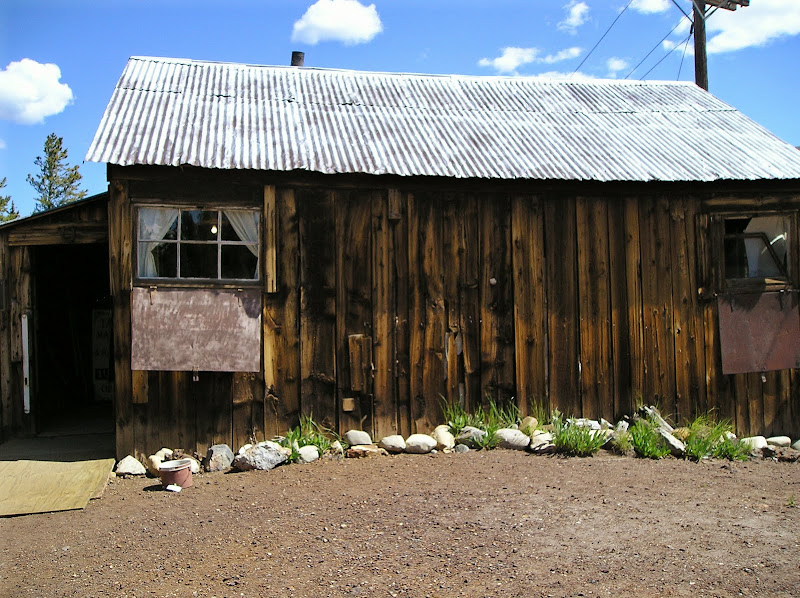
Follow the old stagecoach tracks (along US 24) to the most wild and wicked mining town in the west~ Leadville, Cloud City, two miles high.

In 1860, gold was discovered in California Gulch. Withing five years, the gold had played out and a silver boom followed. In 1880, Leadville had over 40,000 residents, an opera house, over a hundred saloons, dance halls and places of more ill repute. Claims and fortunes could be gambled away or stolen in a night. Doc Holliday stayed in Leadville, Margaret Tobin (Molly Brown of the Titanic) worked as a seamstress and married JJ Brown, owner of the Little Jonny mine. The silver mines made millionaires, and the most fortunate was Horace A. W. Tabor. He established newspapers, a bank and the opera house, and became the mayor of Leadville. His mine, the Matchless, dug up a million dollars in silver each year.

In 1882, Oscar Wilde lectured here on the subject of Aestheticism, and was well-received by the Victorian society of the opera house and the working men in the saloons. A vein of the Matchless was named The Oscar, and Wilde once dined and drank with Tabor and his men at the bottom of the mine.
Fifty year-old Tabor lived the life of a silver king in Denver and his wife, Augusta, disapproved. In Leadville, he found company with Elizabeth "Baby" Doe.

Elizabeth McCourt, Lizzie, was born in Oshkosh, Wisconsin and married an affluent local boy, Harvey Doe. In 1877, Harvey's father sent the newlyweds to make their fortune in the Fourth of July mine in Central City, Colorado. Unexperienced Harvey had a hard time making any profit with the mine, and Lizzie put on pants and boots and worked along with him. Lizzie was very pretty and her spirited behavior raised eyebrows around town. The men of Central City called her "Baby" Doe, the miner's sweetheart.
The Does and their mine soon fell into debt. Lizzie found Harvey to be lazy and a poor provider. He lost jobs and drifted around camps, leaving Lizzie alone for weeks. In 1880, Lizzie divorced Harvey and moved to Leadville with a man named Jake Sands, but soon set her charms upon the most important man in town, Horace Tabor.
Horace divorced Augusta, and he and Lizzie married in 1883, and the Silver King had a queen. The divorce and wedding were terrible scandals. In spite of their difference of age, Lizzie and Horace honestly were in love. They lived extravagantly, handing out silver coins engraved to announce the birth of their daughter, Lillie. Their younger daughter was named Rose Mary Echo Silver Dollar Tabor, called Silver Dollar. Tabor's mines, including the Matchless, brought in millions of dollars of silver and provided for a lavishly grand life, until 1893 when the county moved to a gold standard. Horace lost his fortune and was reduced to working menial jobs at mines that he used to own. Lizzie stayed supportive and faithful to Horace until he died in 1899.
Lizzie was only 38 and still beautiful, and could have easily remarried. Instead, she resourcefully found ways to "hold on to the Matchless", seeking investors and selling silverware and jewelry she had hidden away, to try to keep working the mine.

Lizzie returned to Leadville with Lillie and Silver Dollar and moved into a one-room shed right on top of the spent silver mine.



Fifteen year-old Lillie heard stories about her mother's past in Leadville, and so resented her new home that she borrowed train fare from an uncle and went to live with her grandmother, Lizzie's mother, in Wisconsin. Silver Dollar heard stories of her father, the self-made silver king, and revelled in the legends. She was adventurous, independent, and enjoyed working at the mine. She acquired a burro, and transporation into Leadville, a mile and a half away (like a teenager with a car!). She wrote poetry, and Lizzie helped her to get a song published. "President Roosevelt's Colorado Hunt" was well-received around the state and in 1910, Silver Dollar met the president.
Silver went to parties around town and became involved in scandals of her own. Lizzie now heard stories about her daughter and sent Silver to Denver. There, she worked for a newspaper and wrote a western novel, but then her life spiraled downward. Lizzie and Silver agreed that Silver would join a convent, she moved to Chicago and joined a burlesque show. She lived wildly and sadly, met a tragic fate. Lizzie forever defended that "her" Silver was not the girl in Chicago, that her daughter was safe in a convent.
Lizzie lived alone in the cabin for 35 more years. She dressed in rags, wrapped in burlap, and was too proud to accept charity left at her door. The town was kind, and shopkeepers let her pay for her meager groceries with "valuable ore", rocks picked up around the property. She kept journals on scraps of paper, recording her communications with spirit voices, her delirious thoughts, dreams and visions~ a crazy crone and mountaintop mystic. During a week-long blizzard in 1935, 81 year-old Baby Doe froze to death in her cabin.

A celebrity of sorts, Baby Doe's cabin was picked over by souvenir hunters so few belongings were left there, but the most special thing to her was the shrine now over her bed. She hung pine boughs around it then.

I adored this! She decoupaged Horace's cigar bands to a vase.
Baby Doe's story is so sad and terribly (fabulously) tragic, with the adventure and imagery of legend. Hidden treasure, rags to riches, the highest peaks and tunnels deep under the earth~


1 comment:
great trip ^^
Post a Comment